Our final drive into Texas was exciting in and of itself! First we spent over 18 miles driving on the Atchafalaya Basin Bridge across the Atchafalaya National Wildlife Refuge. For whatever reason this was a surreal experience for me, and although 'ground' (very wet swampy ground) was always below us, it brought back strong memories of driving along the Overseas Highway to Key West. It was somehow fascinating to spend such a long time driving with nothing to see but swamp and more bridge. I tried to capture a photo.
 |
| No matter how hard I tried I just couldn't quite capture the feeling, but hopefully you can get an impression of the neverending bridges in both directions. |
The other exciting thing was much less surreal and much more ha-ha...as we were driving along I-10, quickly approaching Texas, I noticed a slowdown on the map due to an 'object on the road' (according to Google). As we approached, we saw several police cars and officers out of their cars...chasing a cow. I couldn't stop laughing, and somehow it seemed a very appropriate welcome to Texas.
 |
| You may have to zoom the photo to see that the police officer is chasing a black cow. |
Once we finally reached Texas, we stopped just over the border in Lumberton, where we stayed at Village Creek State Park. I went ahead and purchased a Texas State Parks Pass when I booked our first state park in Texas - at only $70 for the year, it is going to more than pay for itself as it waives the per-person daily fees required at every state park (even when you have a campsite reservation!) AND makes the second day of every campsite rental half price. So now in addition to giving us lots of cheap (and hopefully beautiful!) state parks to camp at, it allows us to hop in and out of the gazillion other parks in Texas for quick hikes or bike rides without thinking about fees. Hot tip for anyone else thinking of an extended stay in Texas 😎.
 |
| Our campsite at Village Creek State Park |
 |
| Texas sticker on the map! |
The campground at the state park was fairly small and all the campsites were close together, no privacy to speak of. However, the sites were clean and well-equipped and the bathhouse seemed nice. There was a nature center with an informative ranger and some interesting local wildlife (particularly a siren and an amphiuma - creepy creatures). The small park had several hiking and biking trails and a canoe launch.
I made the mistake of trying to bike down the main trail marked as a bike trail...OOPS. Turns out these are true mountain biking trails. We've been biking on shared hiking/biking trails all along the Gulf coast without difficulty as they were all flat, on firm un-rocky soil, surrounded by trees that don't have roots that poke up from beneath the ground. So I started on this trail without a care...only to find we're out of the coastal plain and into deciduous trees with projecting roots and all sorts of slopes and gullies along the terrain. Later I found out I was on a 'moderate' biking trail...no good for a mostly road-biker like me! The next day Aaron and I took the trail marked 'leisurely'....this took out the gullies and slopes but kept the roots and added in sand traps. We have a long way to go before we're really ready for mountain biking!
 |
| Attempting to pass through a sand trap |
Difficulties aside, the trails had some nice views of the creek and the sloughs that fed it.
 |
| Village Creek |
 |
| One of the sloughs |
We spent another day driving down to nearby Beaumont and seeing the sites there. Turns out the Beaumont area started thriving in the early 1900s due to the discovery of oil at Spindletop with the Lucas Gusher in 1901. This oil discovery launched the American oil industry, several of the major oil companies we still know, and a boomtown in the area. We went to a recreation of some buildings of the era at the Spindletop Gladys City Boomtown. It was interesting to see all the old buildings and the businesses that were necessary for an oil boomtown to function the way it did - including various ways to barter and lease areas of as small as 1/64th of an acre for prospectors to put up their own oil derricks. The photos in the museum of the area at its peak were incredible, with oil derricks crowded all up against each other. It was said you could walk across the whole field of them without touching the ground, they were so close.
 |
| Spindletop Gladys City Boomtown |
Afterward we headed to the park outside the fire museum, where you can find the world's largest working fire hydrant. There are two larger ones in North America but they are not functional. This hydrant was gifted to the fire museum in 1999 by Disney upon the re-release of 101 Dalmations. It was a fun little park and picture.
 |
| World's largest working fire hydrant |
No comments:
Post a Comment